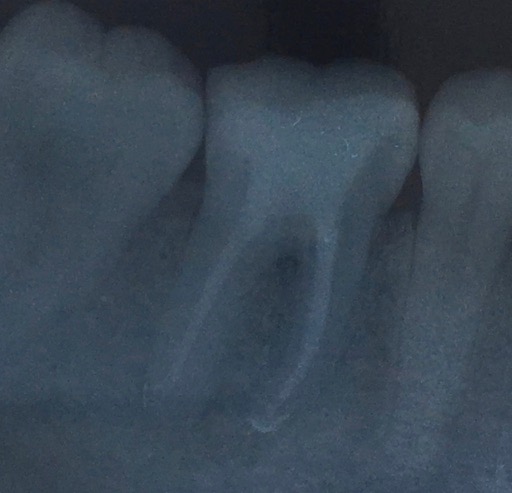Root Canal
Complications
There are several root canal complications that can crop up!
- The first complication is identifying exactly which tooth is the one causing the problem. Sometimes it can be notoriously difficult to be sure. It can feel like the pain is coming from a different tooth to the one that is really the cause.
This is when your dentist has to use all his detective skills!
It's possible for a front tooth to have a bad toothache, when it's actually a BACK tooth that has a problem. This has happened to me personally, and it's very confusing!
 A molar root canal
A molar root canal- The next complication involves teeth that have crowns ("caps") on them. Sometimes, the tooth under the crown is actually tilted or twisted, but the crown has been made to make it look straight.
This means the tiny space inside the tooth will be in a different location than the shape of the crown suggests. The dentist must assess this carefully before he starts!
He will want to start drilling through the crown in the right location and at the correct angle, so that he can find the little root canal space inside. This is why it's important for the dentist to take X-rays from 2 different angles, to see where the root under the gum sits in relation to the crown.
- Different teeth have different numbers of roots. For example, molars usually have three roots. But inside the 3 roots there can be 4 or 5 root canals.
And they can be partly hidden! The dentist must make sure that he finds all these tiny canals, otherwise there is a chance that bacteria could get back into the tooth and cause infection.
The older you are, the smaller the little channels are, because they tend to grow over as the years go by. Sometimes, all the dentist can see is a darker area of dentine, where the root canal use to be. But he can't see if the canal is accessible further down. He has to drill very carefully into the spot of darker dentine, where his training and experience tell him the canal should be.
Millimeter by millimeter, he must chase that spot down, to see if it opens up into a root canal further down. Finally, he may find a tiny opening, and he can use a fine-tipped ultrasonic instrument to remove the last thin layers of dentine over the canal.
Only then can he
start to use his special root canal instruments, to clean out the
problem area. And then he has to do it all over again, for the next canal. As I said, a molar tooth can have 3, 4 or even 5 tiny root canals.
Root Canal Complications
- Although most front teeth have straight roots, the teeth towards the back of your mouth (the molars) usually have curved roots. It can be difficult to treat a tooth with curved roots, because the dental instruments have to be bent by hand to match. There is a small risk of the instrument breaking inside the root canal. And some roots even have a double curve - we call it "S" shaped!
This is where the root canal seems to go straight down for a few millimeters, then it curves one way (usually backwards, away from the front of your mouth), and then towards the end of the root the canal curves back the other way, sometimes quite sharply.
This very awkward for the dentist, as he can't see exactly what's going on. He can use X-rays of the instruments inside the tooth to help, but mostly he's feeling where the instrument is being restricted inside the tooth.
If he is very careful, he may also see the bends in the instrument when he takes it out of the canal every so often to clean it. (This is true of very fine stainless steel instruments, but it doesn't happen to the slightly larger, flexible Nickel-Titanium instruments)>
- One of the less common complications is calcified root canals. As you get older, the tiny spaces inside the root (the canals) gradually get smaller. At some point, they can become completely filled in or blocked, leaving no space behind. This is called a calcified root canal. It can be extremely difficult to treat a calcified canal.
- Some teeth have very long roots, and therefore very long root canals. These can be over 3 centimeters in length. Again, this makes treatment more difficult.
And finally there are complications that arise due to the patient as a whole.
Sometimes a patient cannot open their mouth very wide, or they just have small mouths. Other patients can become restless during treatment, constantly moving their head. That can make doing a root canal rather like trying to mend a small watch while being tossed about, sitting in a small boat at sea!
 small boat at sea
small boat at seaThese are just some of the root canal complications that dentists can be faced with. There are others, but these are the main ones.
Now you can see why doing a root canal is a real challenge for the dentist!



